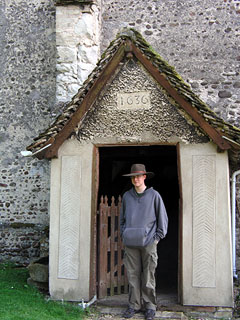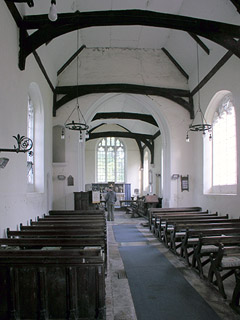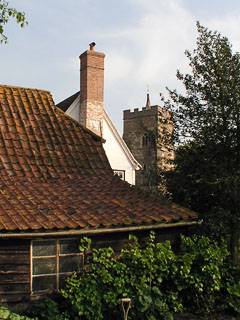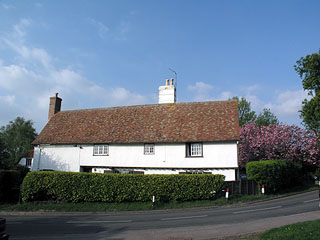St Mary has a lovely location - the churchyard is surrounded by some very mature horse chestnuts, and over the road is a magnificent timber-framed building. Of which more anon, but first let us have a look round the church.
Like its companion St Helen at Little Eversden, St Mary is not a large church. Unlike its companion, though, it was completely rebuilt in the 15th century, after a dreadful fire in 1466. Consequently everything that survives is Perpendicular or later. As readers will know, I like Perpendicular, and I particularly enjoy seeing it used on a small scale as here (another good example is Little Gransden, off to the north-west a little way). The nave is unaisled, which allows the windows to be extremely tall and graceful, and the tower is quite handsome.
The entry, though, is through a post-medieval porch. This is a little timber-framed affair, and is inscribed '1636' over the doorway. There is very little space inside, but there are some substantial pieces of old timber, and quite a few bits and bobs of interesting 18th century graffiti.
Stepping through into the nave, the contrast is very great. As I've said, St Mary is not a big church. However, the nave is tall, and is filled with very low benches, so the space feels very large. Light floods in through the tall windows, and the walls are whitewashed very bright - where the porch felt cosy to the point of claustrophobia, the nave is like a great void. The only piece of furnishing that matches up to the scale is the magnificent 18th century organ that fills the west end.
St Mary underwent two big restorations, in 1864 and 1920. This probably accounts for the scrubbed, slightly sterile atmosphere in the nave.
Moving east, though, there were several interesting bits and bobs that caught my eye. The rood stair survives, for example, but only the upper doorway is still open. The lower one has been blocked in, and now sports a plaque commemorating one Alfred Bate of Muswell Hill, who died here while visiting his brother in the parish in December of 1854. He is buried underneath the pew - rather a sad Christmas that year.
Going further east, the Jacobean pulpit is nice, and there's also what looks like a Jacobean desk in front of the choir stalls. Most of these are Victorian copies, but there are two medieval ones that are quite beautiful. There are little heads between them, and both have misericords. Neither are particularly dramatic (certainly nothing like Over or Gamlingay), but there is a nicely carved shield of the Beauchamp family on one and an intricate ball of leaves on the other.
There's also a design for an altar cloth hung on the north wall of the chancel. It incorporates embroidery of lots of local wild flowers, and is quite magnificent - great umbels of Queen Anne's Lace in the middle surrounded by all the sorts of blooms we had been seeing in the hedgerows, woods and fields all day. The cloth itself was made for St Helen in Little Gransden, but I don't remember having seen it there - I hope it's still used.
Looking up, though, my favourite thing of all was the east window. I realise I tend to go on about clear glass rather too often, but in my opinion there is no stained glass to compare with the view of green trees and blue sky glowing behind the tracery. Here it was particularly lovely - the evening light touched the green of the horse chestnuts with coppery highlights, and the sky was darkening to magnificent azure. It was as though the bright air and the countryside were filling the building, and the void of the nave was filled with gentle, cleansing light.
I had lingered behind when Mark left, and when I emerged I couldn't see him anywhere. As it happened, he had crossed the road to take a photograph and had been accosted by the owner of the lovely house I mentioned earlier, who told him that the best place to photograph the church was from her lawn. We went in, and ended up being given a guided tour of the building. I don't know whether her husband and children thought we were casing the joint with a view to stealing their furniture, but it was nice to be so welcomed. And the house is absolutely stunning - a worthy companion for its ecclesiastical sister across the road.
St Mary was open when we visited.




